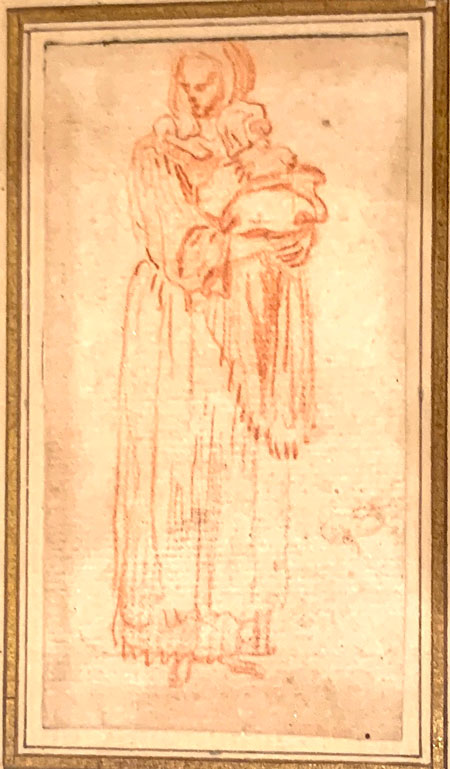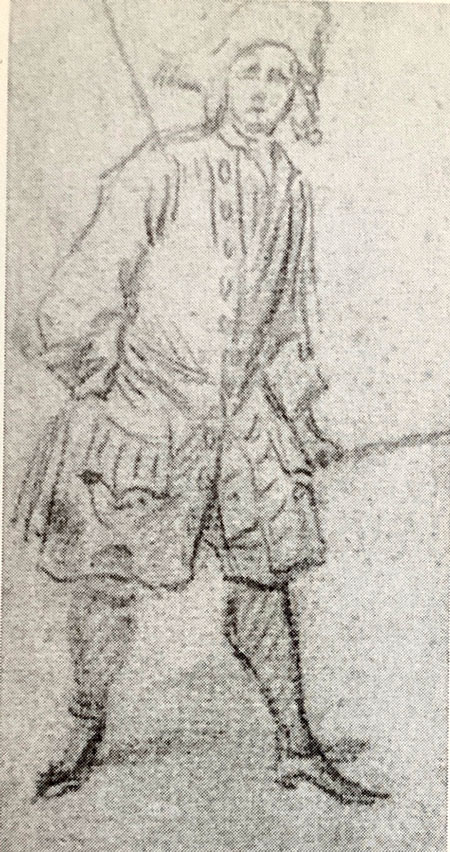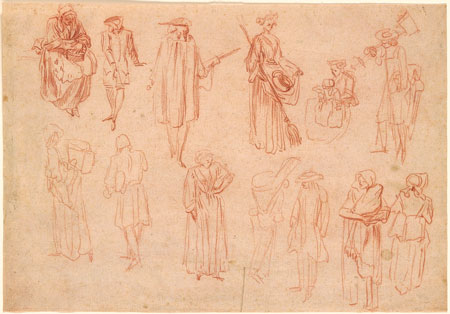A Watteau Drawing Rediscovered
© Martin Eidelberg
Created October 2019
© Martin Eidelberg
Created October 2019
 |
1. Antoine Watteau, Study of a Standing Woman Holding a Baby, red chalk, 8 x 4.5 cm. Ithaca, Cornell University, Johnson Museum. |
Some one hundred and seventy-five miles northwest of New York City, in the handsome new structure of the Johnson Museum, Cornell University, is a Watteau drawing that has not been seen for almost a century.1 It is a small study of a standing woman holding her baby in her arms. Not on view, shorn of its provenance, and languishing under an attribution to Nicolas Lancret, the drawing has not caught the attention of viewers or scholars (fig. 1). It is, after all, a very small drawing, measuring only 8 x 4.5 cm, just slightly larger than a dollar bill.
 |
2. Anonymous French artist, Study of a Standing Man, red chalk, 8 x 45 cm. Whereabouts unknown. |
Originally it probably was a larger sheet and extended further upward, showing the full extent of the woman’s head. But in order to make it match another drawing—a study of a man not by Watteau, it was trimmed (fig. 2). We have a photograph of the second drawing but are unaware of its present whereabouts. As mentioned, in the past it was attributed to Lancret and may still be classified that way, although a more appropriate name needs to be found.
As noted by Rosenberg and Prat, a photograph of the two drawings in the Witt Collection bears an indication that the drawings had been in the Iarevich collection in Russia.2 In the mid-1920s the two drawings were still together and twice appeared on the Paris market. Coming from the collection of “Madame V.,” they were listed in the sale of her collection on March 25, 1925, lot 121: “WATTEAU (attribué à) . . . Figures d’Homme debout et Femme portant un enfant. Deux petits dessins à la sanguine. Haut. 8 cent.: larg. 4 cent. 5.” The drawings may not have sold or perhaps were bought by a dealer who returned them to the auction world with essentially the same wording just a year later, on June 29, 1926. It should be noted that at both auctions they were listed only as “attributed to Watteau,” a never-encouraging classification.
The drawings then disappeared from sight and were separated. When the drawing of the woman resurfaced, it was still in Paris but it apparently was attributed to Lancret. It was brought back to the United States by Frank Robinson, who served as the director of the art museums at the Rhode Island School of Design and at Cornell University. When he donated the drawing in 2006, it was still classified under Lancret’s name.
Rosenberg and Prat, knowing the two drawings only from the photograph in the Witt Library, rejected them. However, on further consideration one realizes that the two drawings should not be judged together. The drawing of the man is executed in broader terms and with more energetic lines. It is larger in scale and fills more of the page. The study of the women, on the other hand, is more delicately executed, with carefully wrought lines. Her elongated proportions are apparent when contrasted with the heavier, broader aspect of the man. His face is wider and the features less finely delineated.
 |
3. Antoine Watteau, Studies of “Popular Types,” red chalk, 23.6 x 33.8 cm. New York, Pierpont Morgan Library and Museum. |
Watteau’s study of the mother and child resemble in type and execution a number of other early studies by the artist. A page of studies of “popular types” in the Morgan Library and Museum is particularly pertinent.3 It contains thirteen such studies, of which the mother and child at the right bottom of the page is closest in typology (fig. 3). However, as Watteau drew the studies, starting at the upper left, he drew them more rapidly. The first five are the most detailed while the later ones are increasingly schematic. Within this context, the moderately explicit nature of the Ithaca drawing aligns it with this first group. Watteau drew another such group of popular types on a sheet now in the British Museum.4
Rosenberg and Prat, knowing the two drawings only by the Witt Library photographs and considering the attribution of the two together, rightly recognized their close relationship (especially the mother and child) to the figures on the Morgan sheet. Perhaps if they had considered just the drawing of the mother and if they had been able to examine it firsthand, they too might have recognized Watteau’s authorship.
NOTES
1 I am grateful to Andrew Weislogel and his staff at the Johnson Museum for their help.
2 Pierre Rosenberg and Louis-Antoine Prat, Antoine Watteau, Catalogue raisonné des dessins (Milan: 1996), cat. 3: R 637-38.
3 Ibid., 3: cat. R 637-38.
4 Ibid., 2: cat. 528.